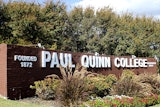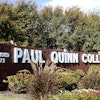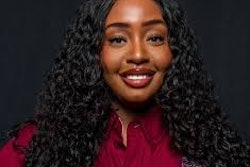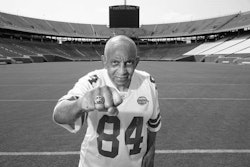Before the Mississippi Valley State University (MVSU) men’s basketball team got booted from the National Collegiate Athletic Association’s 1996 tournament, the historically Black school got sneakered.
The university came into the 64-team “March Madness” tournament not only as a monumental underdog to first-round opponent Georgetown, but also as the only tournament team with out a tie-in deal with a sneaker company.
Superstar alumnus Jerry Rice came to the rescue by persuad ing Nike, for whom he does endorse ments, to provide sneakers and warm-up suits for the Delta Devils. But the team, with its new duds, went down to defeat as Georgetown romped to victory.
This incident made it clear how poorly Black schools fare in the battle over shoe deals. While most Black schools have some sort of promotional deal, there is a consensus that none have the lucrative, megabucks contracts that often provide millions of welcome dollars to other colleges and universities.
Some argue that the Black schools are slighted in shoe deals; others say the schools are their own worst enemies when it comes to striking deals.
Bigfoot Contracts
Nike had its sneakers on the flying feet of 35 tournament teams, including South Carolina State University, the other predominantly Black school that qualified for the tournament.
Reebok, which jousts with Nike for supremacy in the sneaker world, put its wares on seven teams and uniforms on five. Fifteen teams in the tournament sported Converse shoes, while six wore its uniforms. Adidas clad the collective feet of five teams.
Though grateful to Nike for its assistance in the tournament, Charles Prophet, MVSU athletics director, said he would like to see a stronger commitment from the company, or other shoe companies, to his and other historically Black institutions.
“It would be of tremendous help,” he said, “We can’t pay our coaches what they deserve with our budgets.”
Many coaches at larger, predominantly white institutions receive monetary compensation from these companies — often $1 million or more per year — in addition to a virtually limitless supply of sneakers.
“I would be foolish to think my coach should make the same as Jolm Thompson,” he said, but, like Georgetown, MVSU also offers basketball clinics to youth, just like Georgetown. “He’s got Black kids, we’ve got Black kids. Why can’t we get shoes and uniforms? It would be of tremendous benefit if they gave us some thing,” said Prophet.
Discards and Leftovers
A few years ago, MVSU had some “participation” arrangements with Reebok, said Prophet, whereby the university received warm-up gear and footwear. “They were not top of the line, but they gave them to us. But they stopped that,” he said. The school also received free Adidas gym bags that were leftovers from another school.
Since then, the university has sought a better deal with the manufacturers, but to no avail even though the men’s team has qualified to go to the dance three times in recent years.
Said Prophet: “We’ve been getting leftovers. … We don’t want to [be] a leftover school.”
It is better at Howard University, where basketball coach Mike McLeese said that Reebok pro vides a “compensation package” for him and his assistants. He declined to say how much compensation is provided but included in the package are shoes and warm-ups. The team also has a uniform and ball deal, McLeese said, estimating that the total savings to the university is about $40,000 a year. The sum is modest in terms of some deals other schools are able to make, but given the small athletic budgets of schools like Howard, the savings is substantial. “It is a great situation for the university,” he said.
It is, of course, not even close to the exposure Nike gets from having Big East Georgetown players wear Air Jordans on national television, McLeese said.
“Look at this from the shoe companies’ perspective. They feel it is about exposure,” McLeese said. “They’re looking at teams they know are going to be on national television, or conferences that have exposure. But the shoe companies need to look at HBCU’s, especially since young African American males are the ones buying their product.”
Togetherness Matters
Historically Black colleges and universities must be more aggressive in terms of marketing, McLeese said. “Those people at Nike, Reebok, Adidas … whatever, are always weighing what ex posure a team is given, what exposure a conference is given and what exposure will that give their product. We have to provide the maximum amount, of exposure we can.”
In agreement is Oscar Butler, interim athletics director at South Carolina State: “We have got to market and push ourselves. We have to take steps and get out there. Can you imagine what it would be like if MEAC (Mid-Eastern Athletic Conference) and SWAC (Southwestern Athletic Conference) got together and said, `We want a piece of the action like everybody else.'”
James Frank, SWAC commissioner, concurred, saying, “Sometimes, we are our own worst enemy. As a conference, I think our job is to try to get all the schools into a marketing program whereby everybody benefits. We need to get historically Black schools into a marketing combine, to get our schools to cooperate … to forsake themselves for the good of the whole.”
When this was tried a few years ago, Frank said SWAC had located a company willing to produce shoes for each school. When representatives met as a conference, the athletics directors were all for the idea, he said, but once back at their individual schools, they balked at the agreement.
“The shoe companies are not interested in the small schools,” said Frank. It is a matter of economics. We have to change the economics by making ourselves more attractive. One way to do that is to act together, not separately.”
COPYRIGHT 1996 Cox, Matthews & Associates
COPYRIGHT 2004 Gale Group
© Copyright 2005 by DiverseEducation.com















